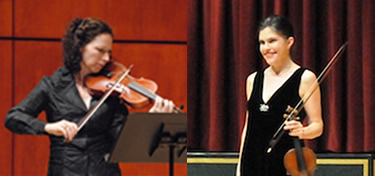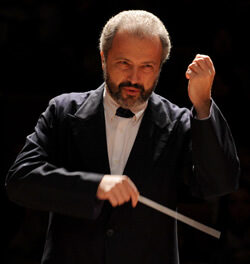Who knew that musicology could be so interesting and that ancient instruments could feel so contemporary? And how is it that these composers aren’t better known? – questions that pop into mind driving home after an exciting concert in Watson Hall on the campus of the University of North Carolina’s School of the Arts.
Glenn Siebert, the world-class tenor who chose to bring his on-stage experience to the UNCSA campus, is the spark which ignites the Magnolia Baroque festival, now in its fifth season. Striding onto the stage inhabited by a harpsichordist, a theorbist and a gambist, to welcome the audience, he started – “Hit it, boys!” – but noting the absence of the “Divas,” disclosed that the three “boys” were only the demi-gods. And indeed, in Baroque music, the bass line is usually played by a low-pitched bowed string instrument (bass viol, cello, viola da gamba or the modern double bass), and a plucked string instrument, usually capable of fleshing out the harmony (harpsichord, lute, guitar, or theorbo). They are the “demi-gods” without whom these works cannot be properly played.
The opening piece on the program was a Trio Sonata by Henry Purcell, the great English composer one of whose themes was orchestrated by Benjamin Britten as a Young Person’s Guide to the Orchestra. Despite the “trio” in the title, the entire ensemble of five performed, featuring the two divas on Baroque violin and allowing us to explore the sounds and style, as one tests the waters in spring. The “Divas” delivered; Ingrid Matthews and Julie Andrijeski are both superb violinists and the sonata’s four movements, ending in what sounded like a gigue, were a pleasure to hear.
Paring down to three instruments, Ingrid Matthews, on Baroque violin with its pointed bow, was joined by Brent Wissick, viola da gamba, and Joseph Gascho, harpsichord. Together they played the Sonata in D minor by Elisabeth Jacquet de La Guerre (1665-1729). The longer and somewhat meandering work, which Ms. Matthews played exquisitely (by memory), was written by a female composer at the court of Louis XIV, a rarity in those days.
The first half of the concert closed with Ms. Andrijeski playing the Sonata in D minor by virtuoso violinist Jean-Féry Rebel (1666-1747), subtitled “La Fidèle” (The Faithful One). The composer may well have been referring to Penelope as the faithful wife for a few years later he wrote his only opera, Ulysse. Ms. Andrijeski played beautifully, using facial gestures as expressive as the music. At one poignant moment, the music almost dies away, as if the wait for Ulysses’ return was unsustainable.
The most memorable work came immediately after intermission with the Ciaconna (Chaconne) of Antonio Bertali (1605-1669). Whereas modern audiences have come to expect a stately dance in a slow three meter (see Bach’s Chaconne in D Minor for violin), this early Italian piece was almost jazzy and certainly humorous at times. While Ms. Andrijeski played half a hundred variations, mostly quick, but occasionally thoughtful and introverted, the cello (Brent Wissick), harpsichord (Joseph Gascho) and guitar (John Lenti) played the same two-bar ground bass over and over, with only occasional changes or modulations. So high was the energy in this piece that I felt like bursting out with a verse of La Bamba!
The next two pieces were effectively treated as two movements of a single work. First, Ingrid Matthews played “La Luciminia contenta” (The Happy Lucy-goosy) by Marco Uccellini (1603-1680), a short thoughtful introspective portrait punctuated by flights of virtuosity. It was joined seamlessly to a Trio Sonata in D minor by Dario Castello (c. 1590 – c. 1658) about whom little is known, but who seems to have left a substantial number of works, many of which have only been published recently. This sonata is a conversational dialogue between the two divas, who maintain constant contact, visual and aural, in a sort of enhanced state of consciousness. I know from experience this thrill of virtuosic challenge, akin to the dare-devilry of high speed sports.
All this was building up to what harpsichordist Joseph Gascho described as the “perfect storm,” as two divas came together in the work of the towering Italian Baroque composer Antonio Vivaldi (1678-1741), La Follia. Several hundred composers have penned their own version of this ancient chord progression, among them Corelli, Bach and Handel. Essentially variations on a 16-bar ground bass in a minor key this performance was indeed the “perfect” storm. A pregnant pause about two thirds of the way through the 10 minute piece produced a tender, nostalgic and inquisitive variation, which in turn gave way to an ever increasing intensity and a solemn end.
This concert emphasized to me the playful, whimsical and improvisatory nature of the early baroque, especially the Italian works featured on the second half of the concert. This is a far cry from the compelling and formal nature of the works of Bach or Haendel.
The decent-sized audience that penetrated the maze of unmarked detours and roadblocks surrounding the latest construction site on the UNCSA campus (expanded library facility and enhanced chancellery) applauded enthusiastically and rewarded the performers with a well-deserved standing ovation.
There are five more concerts in this year’s Magnolia Baroque Festival. See the sidebar for a list of their concerts.












